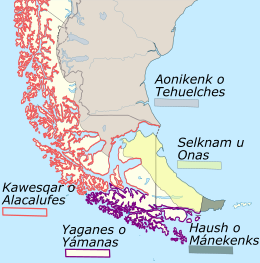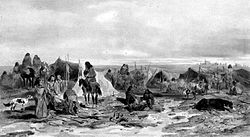Tehuelche people
This article may be expanded with text translated from the corresponding article in Spanish. (October 2011) Click [show] for important translation instructions.
|
 Tehuelche chiefs K'achorro, K'oparren, and Kamayo (1903) | |
| Total population | |
|---|---|
| 27,813 (2010 census)[1] | |
| Regions with significant populations | |
| 4,351[2] | |
| 6,239[3] | |
| Languages | |
| |
| Religion | |
Animism (originally) | |
| Related ethnic groups | |
Haush, Selknam, Teushen | |

The Tehuelche flag: The blue of the sea, the brown of the mountains, the black arrow pointing north and the Southern Cross.[4][5]

Distribution of the pre-Hispanic people in the Southern Patagonia
The Aónikenk people, better known by the exonym Tehuelche, are a group of indigenous peoples of Patagonia and the southern regions of Argentina and Chile.
They are widely believed to be the basis for the Patagones described by European explorers.
It is possible the stories of the early European explorers about the Patagones, a race of giants in South America, are based on the Tehuelche, because the Tehuelche were typically tall, taller than the average European of the time.[6]
According to the 2001 census [INDEC], 4,300 Tehuelche lived in the provinces of Chubut and Santa Cruz, and Río Negro, an additional 1,637 in other parts of Argentina. There are now no Tehuelche tribes living in Chile, though some Tehuelche were assimilated into Mapuche groups over the years.[7]
Contents
1 History
2 Lifestyle
3 Language
3.1 Flag
3.2 Notable Tehuelche people
4 Notes
5 References
6 External links
History

Tehuelche camp, 1838.
The Tehuelche people have a history of over 14,500 years in the region, based on archeological findings.[8] Their pre-Columbian history is divided in three main stages: a stage with large rock tools, a stage where the use of boleadoras prevailed over the peaked projectiles, and a third one of highly complex rock tools, each one with a specific purpose.[9] The nomadic lifestyle of Tehuelches left scarce archeological evidence of their past.[10]
They were hunter-gatherers living as nomads. During the winters they lived in the lowlands, catching fish and shellfish. During the spring they migrated to the central highlands of Patagonia and the Andes Mountains, where they spent the summer and early fall, and hunted game. Although they developed no original pottery, they are well known for their cave paintings.,[8][11][12]
The Spanish arrived in the early 16th century. On March 31, 1520, the Portuguese explorer Ferdinand Magellan landed and made contact with the Tehuelche people. The Spanish never colonized their lands, with the exception of some coastal settlements and a few missions. It took more than 300 years before the Argentine government occupied southern Patagonia.[13]
Lifestyle

Tehuelches drinking mate while the meat of the asado is roasting, 1895
As nomads, the Tehuelche lived with limited possessions, as they had to move across long distances. Their rock tools were usually made of obsidian or basalt, as those rocks were malleable but not so soft that they broke too easily.[14] Those rocks, however, could be found in only certain parts of Patagonia, so the Tehuelche had to make long journeys to renew their supplies.
The Tehuelche hunted many species in Patagonia, including whales, sea mammals, small rodents and sea birds; their main prey was guanacos and Rheas. Both species were usually found at the same places, as the rheas eat the larvae that grow in the guanaco's manure.[15] Everything from the guanaco was used by the Tehuelche: the meat and blood were used for food, the fat to grease their bodies during winter, and the hide to make clothing and canopies. The Tehuelches also gathered fruits that grew during the Patagonian summer. Those fruits were the only sweet foods in their diet.[16]
Language
The Tehuelche speak Spanish and Tehuelche, also known as Aonekkenk, one of the Chonan languages. With the Araucanization of Patagonia, many tribes started to speak variants of Mapudungun, the Mapuche language.
There is a group of people who want to have their language back and are working on a reclamation program called ¨I am not ashamed of speaking Tehuelche" (kkomshkn e wine awkkoi 'a'ien).[17]
Flag
The Tehuelche people have their own flag.
Notable Tehuelche people
- Inacayal
- Salpul
Notes
^ "Censo Nacional de Población, Hogares y Viviendas 2010: Resultados definitivos: Serie B No 2: Tomo 1" (PDF) (in Spanish). INDEC. p. 281. Archived from the original (PDF) on 8 December 2015. Retrieved 5 December 2015..mw-parser-output cite.citationfont-style:inherit.mw-parser-output qquotes:"""""""'""'".mw-parser-output code.cs1-codecolor:inherit;background:inherit;border:inherit;padding:inherit.mw-parser-output .cs1-lock-free abackground:url("//upload.wikimedia.org/wikipedia/commons/thumb/6/65/Lock-green.svg/9px-Lock-green.svg.png")no-repeat;background-position:right .1em center.mw-parser-output .cs1-lock-limited a,.mw-parser-output .cs1-lock-registration abackground:url("//upload.wikimedia.org/wikipedia/commons/thumb/d/d6/Lock-gray-alt-2.svg/9px-Lock-gray-alt-2.svg.png")no-repeat;background-position:right .1em center.mw-parser-output .cs1-lock-subscription abackground:url("//upload.wikimedia.org/wikipedia/commons/thumb/a/aa/Lock-red-alt-2.svg/9px-Lock-red-alt-2.svg.png")no-repeat;background-position:right .1em center.mw-parser-output .cs1-subscription,.mw-parser-output .cs1-registrationcolor:#555.mw-parser-output .cs1-subscription span,.mw-parser-output .cs1-registration spanborder-bottom:1px dotted;cursor:help.mw-parser-output .cs1-hidden-errordisplay:none;font-size:100%.mw-parser-output .cs1-visible-errorfont-size:100%.mw-parser-output .cs1-subscription,.mw-parser-output .cs1-registration,.mw-parser-output .cs1-formatfont-size:95%.mw-parser-output .cs1-kern-left,.mw-parser-output .cs1-kern-wl-leftpadding-left:0.2em.mw-parser-output .cs1-kern-right,.mw-parser-output .cs1-kern-wl-rightpadding-right:0.2em
^ "Censo 2001 - Encuesta Complementaria de Pueblos Indígenas". Retrieved 29 January 2017.
^ "Censo 2001 - Encuesta Complementaria de Pueblos Indígenas". Retrieved 29 January 2017.
^ "Bandera del Pueblo Tehuelche de Santa Cruz". kketo sh m ´ekot (in Spanish). 2018-07-05. Retrieved 2018-08-21.
^ "Las comunidades Tehuelches levantan su bandera identificatoria en Santa Cruz". www.tiemposur.com.ar. Retrieved 2018-08-21.
^ Fondebrider, Jorge (2003). "chapter 1 (Ámbitos y voces)". Versiones de la Patagonia (in Spanish) (1st ed.). Buenos Aires, Argentina: Emecé Editores S.A. p. 29. ISBN 950-04-2498-3.
^ Southern Chilean native peoples www.icarito.cl August 28, 2010, Corporación Nacional de Desarrollo Indígena (Conadi) retrieved November 29, 2013
^ ab Chiti, Jorge Fernández (1997) | see Monte Verde archaeological site near Puerto Montt. Cerámica indígena arqueológica argentina. Condorhuasi, p. 64.
ISBN 950-43-8095-6. (in Spanish)
^ Bernal, 18-20
^ Bernal, p. 17
^ Arte Rupestre Spanish Atlas vivo
^ EnglishAncient rock art -Living Atlas Chile Video (English subtitles) Tehuelche rock paintings, retrieved November 28, 2010
^ La ocupación efectiva de la región patagónica por parte del gobierno argentino: la "Conquista del Desierto" y las exploraciones del perito Moreno (1879) [1]
^ Bernal, p. 28
^ Bernal, p. 29
^ Bernal, p. 30
^ "kketo sh m ´ekot - Plan de recuperación de la lengua tehuelche". kketo sh m ´ekot (in Spanish). Retrieved 2018-08-21.
References
Bernal, Irma; Proaño, Mario Sánchez (2007). Los Tehuelche. Buenos Aires: Galerna. ISBN 978-950-556-422-4.- Efram Sera-Shriar, ‘Tales from Patagonia: Phillip Parker King and Early Ethnographic Observation in British Ethnology, 1826-1830’, Studies in Travel Writing, 19 (2015), 204-223
External links
| Wikimedia Commons has media related to Tehuelche people. |
- Christine Papp: Die Tehuelche. Ein Ethnohistorischer Beitrag zu einer jahrhundertelangen Nicht-Begegnung, A dissertation. Universitãt Wien (University of Vienna), 2002. (PDF)
Native Patagonians - Contains primary sources and reference material.